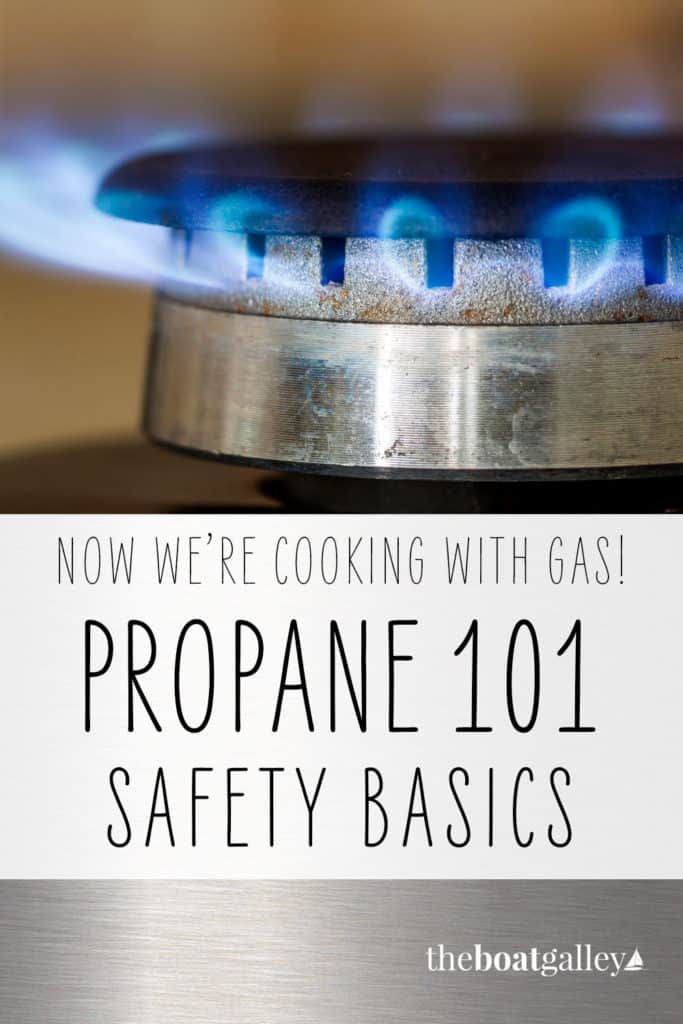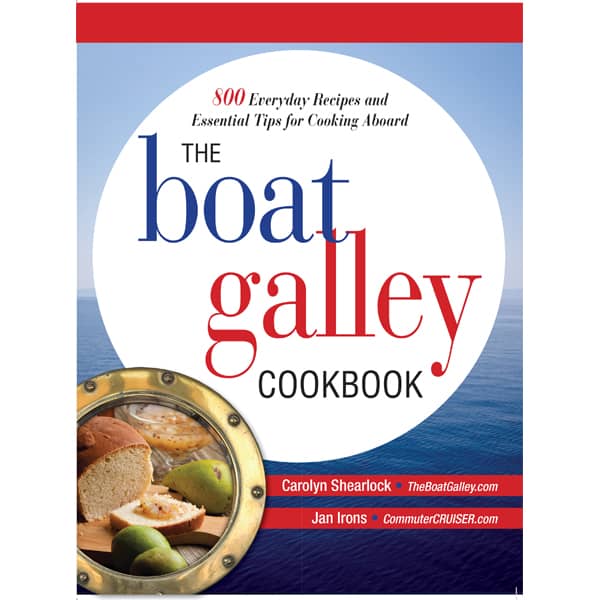
Prior to our first charter trip, I had no idea how to use propane on a boat — I hadn’t even used a propane a camp stove or gas grill! And I had very little experience with a gas stove or oven; about all I remember is a few friends having them and seeing them when I helped in their kitchens, but never using one.
So you could say I had more than a few questions . . . and more as we bought our own boat and began cruising!
Propane Basics
I’m not going to try to cover absolutely everything about how to use propane on a boat in this article (in particular, I’m not covering maintenance or troubleshooting), but basically hit on the important things to know if you’re not very familiar with it.
Explosive
Propane is a potentially explosive fuel. Be careful around it! While some charter companies require you to turn it off at the tank any time you’re not actually using it, most boaters only turn it off when they are going to be away from the boat for an extended period of time . . . say, more than a day.
Propane Smell
Propane actually has no odor, but one is added to it so that you can tell if there is a leak. If you smell propane, turn the propane off at the tank immediately and turn off all electricity and be very careful not to generate static electricity sparks. Propane is heavier than air and “flows” with gravity very similarly to water; it will collect at the lowest point it can reach — generally in the bilge. On most boats, it is safest to use the manual bilge pump to rid it from the boat; do not use an electric pump because of the risk of a explosion from a spark. Be very careful as you locate and repair the leak (specifics of that are way beyond the scope of this article).
Three Important Safety Items
Your propane system has numerous parts, from the tank to the stove. But I want to talk about three in particular and the role they play in your safety.
Propane Locker
If you store your propane in a locker, the locker must be vented directly overboard (not through a hose) from the lowest point in the locker. Propane is heavier than air and any leaked from the tank will collect in the bottom.

Solenoid
A solenoid is a valve in the propane line from the tank to the stove. It’s electrically operated and typically there is an on/off switch near the stove. You turn it on when you’re ready to light a burner and off when you’re done using the stove (with many, a red light comes on when the solenoid comes on as a visual reminder that it’s on). It’s a safety feature and designed to fail closed — which means that if there is no electricity coming from the batteries, it will not operate. Should you lose all power on the boat, you will have to devise a way to bypass the solenoid in order to cook.
As a safety precaution, it’s recommended that when you are ready to turn the last burner off that you’re using to prepare a meal, you first turn the solenoid off and let the propane in the line go to the burner and burn. When the flame goes out, then turn the burner off. Unfortunately, this is often hard to remember in real life and I often found myself either just turning the burner off and later remembering to turn the solenoid off, or turning the solenoid off and forgetting the burner until later!
Thermocouple
Another safety device, this designed to ensure that propane does not flow to the burner if there is no flame there. That is, if the flame accidentally goes out, propane won’t keep flowing (since it is invisible as a gas, it could collect along the floor or bilge and cause an explosion). That’s great, but the question is then how do you get the propane to the burner so you can light it? You have to turn the knob on and push it in — pushing the knob in causes the propane to flow regardless of whether there is a flame or not. Generally, you have to hold it in for a few seconds after the burner is lit until the thermocoupler has a chance to warm up. Check with your stove’s documentation for more details as every stove can be a little different.
Lighting a Propane Stove
Many marine stoves have some sort of automatic or push-button igniters, where you don’t need a match or other lighter. Many use an AA or AAA battery somewhere in the system for the igniter, so if your igniter stops working check your documentation for this. And always keep some kitchen matches and/or long-nosed lighters (like you’d use for lighting a grill) on hand — those igniters are notorious for not working (mine never did, Jan’s doesn’t).
To light a burner with the starter, first turn the solenoid on. Turn the knob for the burner to the “start” or “light” position (or to medium-high if there is no marked “start” or “light”) and push it in and hold it in. Then press the starter — it may take several tries. If it doesn’t light in three or four clicks, let the knob out and wait several minutes before trying again, in order to let the propane dissipate and reduce the risk of a mini-explosion (or worse) when it does light. Continue to hold the knob in for a few seconds until the burner is nicely burning, then let the knob out. If the flame goes out, repeat and hold the knob a little longer (with time, you’ll learn how long it takes with your stove and it’ll be second nature). Now you can adjust the burner to the setting desired.
To light a burner with a “fire starter” (long-nosed butane lighter), again begin by turning the solenoid on. Light the fire starter and hold the flame beside the burner element. Turn the knob for the burner to the “start” or “light” position (or to medium-high if there is no marked “start” or “light”) and push it in and hold it in. It may take a couple seconds until the propane is at the burner, but the burner should light. Remove the fire starter but continue to hold the knob in for a few seconds until the burner is nicely burning, then let the knob out. If the flame goes out, repeat and hold the knob a little longer (with time, you’ll learn how long it takes with your stove and it’ll be second nature). Now you can adjust the burner to the setting desired.
NOTE: If the directions that came with your stove state a different procedure, follow those instead. These are sort of “generic.”
How Long Does a Tank of Propane Last?
Well, that depends on the size, how much and what types of cooking you do and so on. But what I can say is that with full-time living, a 20-pound tank (also called a 5-gallon tank in some places) will last me about 3 months. I bake and do everything I would ashore — in some ways, probably more as I heat dishwasher on the stove and also boil water for coffee instead of using a coffeemaker. I hear this same number from other liveaboards, and even a friend who lives ashore and uses a 20-pound tank.
For boats, the two sizes of tanks most often used are 10-pound and 20-pound tanks. Many full-time cruisers have two tanks, so they are never without. A spare tank needs to be kept where any leak will not drain into the boat.
Refilling the Tank
Our first question was whether the propane tank had to be empty before it’s refilled or could we do it when it was convenient? Nope, it doesn’t have to be totally empty . . . although you’ll probably won’t be charged any less.
Many marinas do a refill service, where you take the tank to the office or other designated place by a certain time on a certain day and someone takes them to the tank farm and returns them generally the same day (sometimes the next day). Other times, you’ll have to go to the tank farm yourself.
In the US, more and more often tanks are exchanged in many places such as home improvement stores, groceries, pharmacies and big box stores. These are easy but note that they usually only have 15 pounds of propane in a 20-pound tank and thus last about 25% less time.
Many boats, particularly in saltwater, have aluminum tanks. If this is the case, don’t use the “swap-a-tank” services you see at so many convenience stores, supermarkets, and so on — those tanks are steel!
Read Next:

Carolyn Shearlock has lived aboard full-time for 17 years, splitting her time between a Tayana 37 monohull and a Gemini 105 catamaran. She’s cruised over 14,000 miles, from Pacific Mexico and Central America to Florida and the Bahamas, gaining firsthand experience with the joys and challenges of life on the water.
Through The Boat Galley, Carolyn has helped thousands of people explore, prepare for, and enjoy life afloat. She shares her expertise as an instructor at Cruisers University, in leading boating publications, and through her bestselling book, The Boat Galley Cookbook. She is passionate about helping others embark on their liveaboard journey—making life on the water simpler, safer, and more enjoyable.
Simplify meal prep on board with proven strategies for provisioning, maximizing fridge space, and cooking delicious meals aboard your boat.










Wendy says
Another great article, thank you.
I was waiting to read about propane sniffer alarms. Do you have one on board? What would you recommend?
I also have noticed how difficult it is to find propane when traveling in the Carribbean. My latest boat delivery from Trinidad to Florida was a challenge propane wise. We could not get it in Trinidad as we left before the day they come to the marina. We couldn’t get it in St. Croix then St Thomas was going to be a $l00 cab ride to find it. We ended up taking a taxi in Turks and Caicos to get some. We were relieved as the owner left us with half a tank for a 3 week trip.
Carolyn Shearlock says
Our new-to-us boat has a sniffer. Since we haven’t moved aboard yet, I can’t really say anything about how well it works in real life — in theory, I think the idea is great!
tami says
I’d like to suggest more emphasis on propane tank lockers
When we bought our boat, one of the conditions of survey was that the propane tank be refitted into a locker, and I understand that these days lockers are pretty much a requirement at least from the perspective of the ABYC
…and it’s a good idea, anyway.
Silverheels III says
Propane is easy to get refilled in every English Island in Eastern Caribbean, Puerto Rico and Georgetown or Nassau Bahamas.
Propane sniffers are ABYC requirements and your insurance might want you to have one too. A simple solenoid switch will turn off the gas manually, but the sniffer will alarm and shut off the gas immediately!
Canadians take note: In USA, refill or exchange stations will not accept or refill a standard 20 pound steel propane tank unless it has a triangular handle on the valve. In Canada, these 20 pound OPD tanks are manufactured with either round or triangular knobs on the top valve. Both are identical in construction and perfectly safe, however the poor guy at the refill station in the US will tell you that it’s not an OPD tank without a triangular handle and will not fill or exchange it for you. We had to give our round handled tank away and buy one with a triangular knob.
Tanks are stamped with manufacture date. Usually they will not fill a tank older than 10 years. We spraypaint out steel tanks regularly to keep ahead of the rust caused by the salty environment at sea.
Michael Matthews says
Great article Carolyn. I can’t imagine having propane on the boat without having a sniffer, rules/regulations or not. I would not feel safe without one. My boat had a sniffer (too long ago to remember the brand) and it went off from time to time as it smelled something. Every time it was nothing to worry about but it sure was great peace of mind. We had our propane tanks in a locker that was sealed from the rest of the boat and vented overboard at the lowest point. The solenoid turned off the gas inside the tank every time we weren’t using it. Propane is fabulous to cook on and it’s safe when treated with respect and with the proper installation. It can be deadly if not. I saw a boat in Pender Harbor that was badly damaged and badly burned by a propane fire. It’s the sort of thing that nightmares are made of but I think with proper installation and precautions it’s a wonderful thing to have on a boat.
Ernie Lorimer says
A suggested rule of thumb for use is 1 pound per person per week for full time.
You can have a propane tank that is more than 10 years old recertified, which is good because the aluminum or fiberglass versions are wicked expensive.
If you are in doubt about how much propane is in the tank, weigh it with a little luggage weigher, the kind that you suspend the luggage from and has a little red line to indicate the max weight. The tank will have a tare (empty) weight stamped on it, The difference is the weight of the propane.
Carolyn Shearlock says
We don’t use quite that much — 15 pounds lasts two people 12 or 13 weeks full time with baking — but that rule of thumb is generally good and will ensure you don’t run out.
Florian Wolf says
Or tap the bottle from top to bottom with eg a key, a small spanner etc. & listen for the change in sound – that’s where your propane level is at the moment. Works with all kinds of bottles.
Matt Satterlee says
Greetings! Mariner Princess is no longer in business and our stove needs some adjusting or fixing. Top burners will not light. One burner started to fail before the other one but both have now bit the dust. I don’t want to install a new one as I just need to understand these systems so I can trouble shoot it. I have the manual but it’s no where near the detail that I need.
I’ll start with a cleaning of the area beneath the stove top and check for anything loose.
Propane is getting to the burners per the smell. As time went on…the burners became more difficult to light and to keep lit. I’m unsure if I’m getting enough of or have spark.
Is there anyone else that is an expert on these propane stoves or can give me direction and a place to start?
Mahalo & Aloha!
Carolyn Shearlock says
Try cleaning the jets and the burner orifice. Use a long-nose butane lighter to light it if you don’t seem to be getting a spark from the built-in igniter.
David Casey says
Yes try cleaning jets and orifice, any spills when cooking tends to clog them up. We are talking about the small holes where the gas comes out of the burners and becomes flames. This also happens on the common cookstoves in homes.
Christine says
I am curious to hear about the use of the one pound refillable tanks for the grill. I would take the small tank to shore for refill. I’m not interested in refilling myself.
Matt says
Great article. I truly need the info you provided in Propane 101. I’m confused about propane pressure in the tank and at the burner. I think there is a ‘regulator’ attached to the line that is screwed onto the tank. This reduces the pressure of propane flowing out of the tank to a level acceptable to the stove burners – I think. Is this correct?
For my grill, I use small green propane bottles. Would it be unsafe to eliminate the green bottles and use a hose without a regulator to feed propane from the tank to the grill?
Carolyn Shearlock says
Yes, there is a regulator in the line. You can use propane from a tank instead of the little green bottles (that’s what I do) but it generally requires an adapter and a regulator — check in your owner’s manual or with the manufacturer as sometimes the same regulator works for both, sometimes you need a different one.